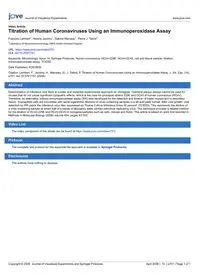
2008 Titration of Human Coronaviruses Using an Immunoperoxidase Assay PDF
Preview 2008 Titration of Human Coronaviruses Using an Immunoperoxidase Assay
Journal of Visualized Experiments www.jove.com Copyright © 2008 Journal of Visualized Experiments and Springer Protocols April 2008 | 14 | e751 | Page 1 of 1 Video Article Titration of Human Coronaviruses Using an Immunoperoxidase Assay Francine Lambert1, Helene Jacomy1, Gabriel Marceau1, Pierre J. Talbot1 1Laboratory of Neuroimmunovirology, INRS-Institut Armand-Frappier URL: https://www.jove.com/video/751 DOI: doi:10.3791/751 Keywords: Microbiology, Issue 14, Springer Protocols, Human coronavirus, HCoV-229E, HCoV-OC43, cell and tissue sample, titration, immunoperoxidase assay, TCID50 Date Published: 4/28/2008 Citation: Lambert, F., Jacomy, H., Marceau, G., J. Talbot, P. Titration of Human Coronaviruses Using an Immunoperoxidase Assay. J. Vis. Exp. (14), e751, doi:10.3791/751 (2008). Abstract Determination of infectious viral titers is a basic and essential experimental approach for virologists. Classical plaque assays cannot be used for viruses that do not cause significant cytopathic effects, which is the case for prototype strains 229E and OC43 of human coronavirus (HCoV). Therefore, an alternative indirect immunoperoxidase assay (IPA) was developed for the detection and titration of these viruses and is described herein. Susceptible cells are inoculated with serial logarithmic dilutions of virus-containing samples in a 96-well plate format. After viral growth, viral detection by IPA yields the infectious virus titer, expressed as 'Tissue Culture Infectious Dose 50 percent' (TCID50). This represents the dilution of a virus-containing sample at which half of a series of laboratory wells contain infectious replicating virus. This technique provides a reliable method for the titration of HCoV-229E and HCoV-OC43 in biological samples such as cells, tissues and fluids. This article is based on work first reported in Methods in Molecular Biology (2008) volume 454, pages 93-102. Video Link The video component of this article can be found at https://www.jove.com/video/751/ Protocol The complete text protocol for this experimental approach is available in Springer Protocols. Disclosures The authors have nothing to disclose.
